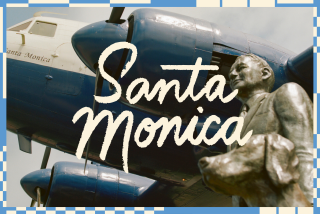Warm glow at Perez Art Museum Miami goes beyond South Florida sun
MIAMI — What would you do here if you had 36 hours to kill here? Tour an Art Deco neighborhood? Dine on goat stew at Tap Tap? Sample mojitos in the bars of South Beach?
They’re all noble ideas. But I had to add one more to the list: a visit to the Pérez Art Museum Miami, a relatively recent addition to the city’s cultural landscape that overlooks Biscayne Bay.
When it opened in December 2013, local boosters spoke of its immediate iconic status. How could I pass that up?
The $131-million museum building was designed by Swiss architecture firm Herzog & de Meuron (which also turned a London power plant into the Tate Modern). It is known for its collection of modern and contemporary artworks from the Americas and the Caribbean. (Developer Jorge M. Pérez donated $40 million in art and cash.)
The first version of the museum, the Center for the Fine Arts, was founded in 1984; it was later rechristened the Miami Art Museum. But civic leaders continued to push for something grander, a new institution that would command national and international attention.
Not everyone in Miami’s art world was happy about the prospect of more change. As a new building was being planned, critics complained about public subsidies (from a Miami-Dade County bond package) and the renaming of the institution after a wealthy donor.
But I heard no complaints during my visit in late March.
The morning I arrived, shortly after the museum opened, visitors were scarce, but they started to populate the galleries in a matter of minutes — families, couples and matrons arm in arm speaking English, Spanish or Portuguese. Guides and guards were generous with their time and their answers. No one admonished small children to use their indoor voices.
Everyone I encountered at the 200,000-square-foot museum — the ticket sellers, the cashiers in the gift shop, the women at the coffee bar — was eager to please.
Was it OK for two children to pose for photos under a Thomas Hirschhorn piece called “Necklace CNN” that was mounted on a wall? Of course. Did I want to read more about the works of Antoni Tàpies? Go through those doors to the next gallery.
As I was inspecting an artwork that had been painted on an enormous wall, a guide gently held my elbow and walked me back 15 feet. There were hidden figures in the work, he explained, and I could see them better from a greater distance.
The Miami Herald described the three-story building at its opening as combining “a subtropical aesthetic inspired by the natural South Florida landscape and folksy wood construction.” As visitors approach the ground-level entrance, they are greeted with astonishing hanging gardens that are suspended from a slatted roof. The gardens also are works of art; vegetation adorns 18-inch-diameter tubes made of fiberglass and felt.
How many plants? I estimated a jillion; museum literature says there are 54,700 plants (77 species). The gardens were also designed to withstand hurricane winds up to Category 5, the most severe category.
Inside, several of the galleries were devoted to a group of paintings, sculptures, photography, video and mixed media titled “Global Positioning Systems,” with artworks from the permanent collection alongside loans from private collections. They include Patricia Cronin’s bronze “Memorial to a Marriage” and Jonathan Hernández’s “Rongwrong XXIV” newspaper collage on cardboard. The goal? Explore “the intersection between globalization and history.”
The museum had just opened an exhibition of works by Barcelona-born Tàpies. Its 50 pieces include drawings, assemblages and mixed-media paintings. Otherworldly figures dominated a handful of his early paintings. Were they ghosts? Aliens?
Some of his canvases included old clothing, wood splinters, sand and straw. There was a pile of blankets in one gallery and a series of old garments or bedclothes draped (“Chair and Clothes”) on a chair in another.
But there was also warmth in the room from a different source: the museum workers who quietly stood in each gallery, looking, presumably, to stop enthusiastic museum-goers from trying to touch the straw or the blankets, but also to offer guidance.
After my three-hour tour of the museum, I sat outside on the wrap-around porch and ate an enormous chocolate chip cookie and drank an espresso. The temperature was verging on warm; the breezes, cool. I could have lingered for several hours — and perhaps that was the point.
As for those mojitos, I should note my appreciation for the bartender at the Havana 1957 restaurant in South Beach who took to heart my request to “make it strong.” Fortunately, my hotel was only an eight-minute walk.
On another night, during a remarkable meal of conch ceviche, goat stew and fritters at the Haitian restaurant Tap Tap, I encountered another notable mojito. It was made, I was told, with Haitian rum.
Later in the evening I found a review of the drink in the Miami New Times: “Sorry, Cuba, but with rum so clearly superior, the Haitian mixologists at Tap Tap have beaten you at your own game.”
::
If you go
THE BEST WAY TO MIAMI
From LAX, American and Delta offer nonstop service to Miami, and American, US Airways, Delta and United offer connecting service (change of planes). Restricted round-trip fares from $422, including taxes and fees.
Pérez Art Museum Miami, 1103 Biscayne Blvd., Miami; (305) 375-3000, www.pamm.org. Open 10 a.m. to 6 p.m. Tuesdays and Wednesdays, Fridays-Sundays; 10 a.m. to 9 p.m. Thursdays. Adults, $16; seniors, students and youth ages 7-18, $12.
More to Read
Sign up for The Wild
We’ll help you find the best places to hike, bike and run, as well as the perfect silent spots for meditation and yoga.
You may occasionally receive promotional content from the Los Angeles Times.







